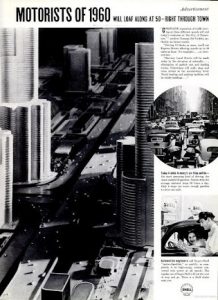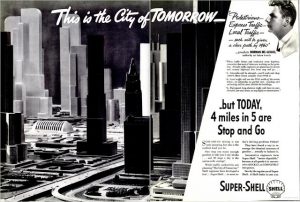When Norman Bel Geddes was asked to design an advertising campaign for a new type of gasoline for Shell Oil, he designed a futuristic city. Why just sell people gas if you can make them dream about a future with more cars, but less traffic?
His “City of Tomorrow” campaign managed to make cars and driving an essential component in an exciting idea for the future. It accomplished the company’s marketing interests, while also going a step beyond to inspire an interest in innovation for many who viewed the advertisement.
The 1930’s campaign imagined cities of the 1960’s with highway systems and skyscrapers – cities designed with the efficiency to  house more people and make it easier for them to get around. It showed cities that seemed like a distant dream to people of the time, but mostly look kind of familiar to us now.
house more people and make it easier for them to get around. It showed cities that seemed like a distant dream to people of the time, but mostly look kind of familiar to us now.
Bel Geddes took his ideas even further at the famous “Futurama” exhibit at the 1939 New York World Fair. This is the creation that Bel Geddes is most remembered for. His sizable dioarama of another proposed city of the future, attracted huge crowds and was the talk of the town. Funded by and representing General Motors this time, it was another example of Bel Geddes going far beyond the needs of the brand and supplying his client with a piece of advertising that would far outlive most in its cultural influence and memory.
Shell and General Motors benefited from the ideas of Bel Geddes, but the influence of those ideas went far beyond the companies and made an impact on how cities were conceived and designed moving forward. Not all of Bel Geddes’ suggestions for better cities have been widely incorporated, but enough have to make his influence on how our cities look today undeniable.
The best marketing comes from ideas that aren’t just about selling a product. They give the audience something to think about, care about, or provide something of tangible value. Bel Geddes’ idea hit the jackpot, appealing to all three of these. The man was inventive and innovative on a level few people can reach. Even without access to that level of creative genius, there’s an easy to achieve marketing lesson to take away from his work.
Don’t just sell when you can inspire, make people think, or equip them with information of value to them. Go beyond making a case for why your product’s good and think of ways its uses can be tied to information or stories that will educate, entertain, or otherwise satisfy a need or desire that your target audience has.
What Bel Geddes did was content marketing long before the term became common in marketing circles. It’s just one more way he was ahead of his time.
*Images and a more thorough article on the “City of Tomorrow” campaign here.
